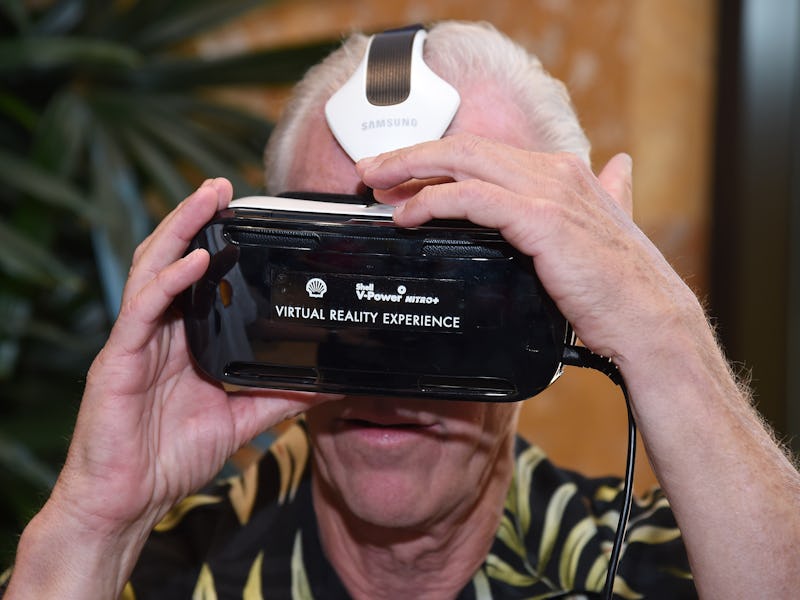5 Ways Virtual Reality Therapy Can Help Conquer Real-World Fears
When virtual reality goes beyond leisure.

The second coming of virtual reality has been heralded as a boon to gaming and, potentially, a way to reinvent the social net. BAnd with more immersive potential comes therapeutic aspects as well, particularly in the realm of psychiatry and mental health. It hasn’t been easy to get this tech everywhere, as Stéphane Bouchard, a researcher at the Université du Québec en Outaouais who’s been using VR to study anxiety disorders since the late 90s, tells Inverse. Historically, VR has been a prohibitive laboratory expense (up to $25,000 a decade ago). Plus, people get into the psychotherapy game to help people, not code, Bouchard notes, and might be wary of having to learn a new skill.
That’s not to say VR can’t help people. It has. Let’s dive in:
Virtual spider sense.
The first time Bouchard hired a graphic artist to develop software to expose phobic individuals to spiders, the designer proposed a nightmarish Alien-like scenario in which a mother spider lays eggs that hatched out of your middle regions. “It’s a cool idea for a programmer,” Bouchard says, “but so far away from what I need as a therapist.”
Once the giant alien critters were toned down to more earthly dimensions, Bouchard’s arachnophobic investigations showed promise. In a small study of 10 women and one man — many of these pilot VR studies have been small — phobic individuals who saw spiders through a modified Half-Life engine self-rated improvement at handling their fear of arachnids.Fighting flying fears.
Exposure therapy is a great way to handle phobias, but simulating flying without VR is logistically and financially tough. With VR headsets — and, possibly, giant robot motion simulators — you get the sensation of flying on the relative cheap. And this appears to work. When Emory University researchers reviewed eight VR aviophobia trials in 2008, they concluded that a combination of VR exposure and cognitive therapy yields the best results than non-VR exposures or other therapies alone.
Post-Traumatic Re-Immersion
In early pilot studies, soldiers suffering from post-traumatic stress disorder decreased their symptoms after being exposed to digital war-like environments. The University of Southern California has, since 2005, been using art from the Xbox game Full Spectrum Warrior to mimic Afghani and Iraqi environments in its project Bravemind. The idea is to replicate frightening environments without replicating fear.
Social Interactions for Loners
If you have a fear of speaking, giving a talk to room that is simultaneously empty and yet full of digital bodies might help as much as controlled therapy in a real-life setting. In a 12-week trial involving 36 participants, virtual reality and group therapy were equally effective for those trying to overcome anxieties about specific social interactions.
Tools for Compulsives
Can virtual reality help with eating disorders like anorexia and bulimia? Psychologists at the University of Barcelona think so, having used virtual reality to expose volunteers with eating disorders to “four experimental virtual environments: a kitchen with low-calorie food, a kitchen with high-calorie food, a restaurant with low-calorie food, and a restaurant with high-calorie food,” in a 2010 study in the journal Cyberpsychology, Behavior, and Social Networking. Body-distortion cues were higher after the subjects visited these environments, particularly those with high-calorie food. That’s paved the way for future VR studies, like an ongoing University of Barcelona clinical trial for volunteers with bulimia nervosa. It’s not yet recruiting, but the study hopes to couple eating disorder VR with cue-exposure therapies like those that have shown success with phobias.
Much, Much More
Because many of these trials have been so limited in scale, two researchers at the University of Southern California, in a 2008 meta-analysis of medical VR, have called for more rigorous testing in groups of at least 30. Psychologists also believe that virtual reality could be used to get a better handle on, say, premature ejaculation in addition to phobias. Bouchard also sees a wave of unusual experiences headed our way, once the consumer VR flood gates swing open. “If you can swap bodies, and are undressing as a women — if you’re a man — what impact does it have on a child’s development?” he says. VR psychiatry doesn’t have the answer — yet.